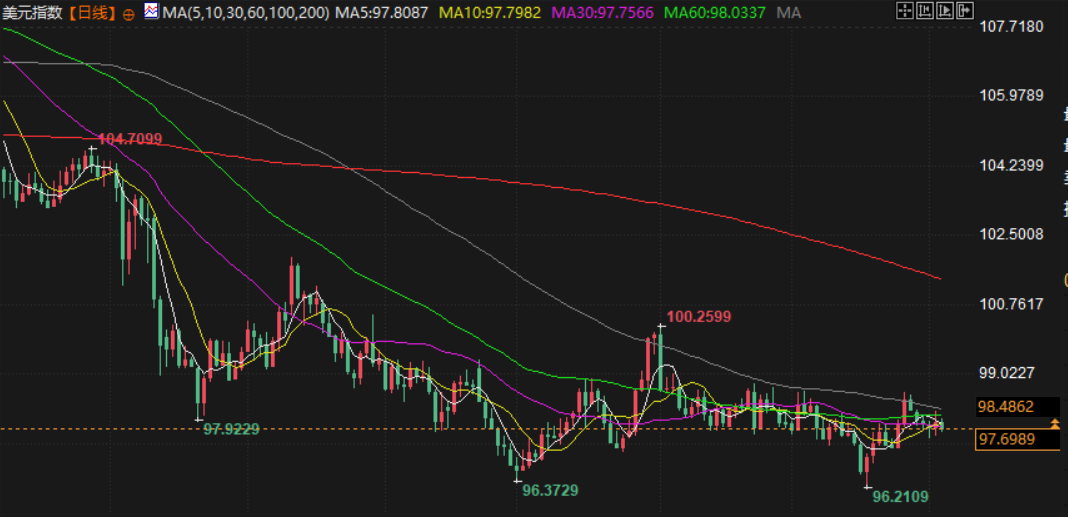The US government shutdown is at an impasse, with traders betting on a prolonged period. More layoffs could be bearish for the dollar.
2025-10-04 06:50:40

With little clear progress toward breaking the impasse between President Trump and congressional Democrats, traders are increasing bets on a prolonged government shutdown. Bettors on the prediction market Kalshi believe there is a 70% chance the shutdown will last more than 10 days, up from around 45% when the shutdown began on Wednesday. Over the same period, the probability of a shutdown lasting more than 15 days has risen from 36% to 46%.
Some are betting on the long-shot possibility that this standoff will become the longest on record, surpassing the 2018-2019 shutdown during Trump's first term, which lasted 34 days, according to Dow Jones Market Data. This means there is a 16% chance that the current shutdown will last more than 35 days.
Fitch Ratings said in a report that a prolonged U.S. government shutdown could lead to a modest slowdown in economic growth. "A prolonged disruption, particularly if accompanied by significant capital withdrawals or layoffs, could slow U.S. economic growth by a small amount."
The dollar rose against the yen, up 0.1% at 147.44 yen, after earlier falling as much as 0.4%. The greenback was still on track for a 1.4% gain against the yen for the week, its biggest gain since mid-May.
Bank of Japan Governor Kazuo Ueda struck a cautious tone in his comments on the global economy, reducing expectations of an imminent interest rate hike, contributing to the yen's weakness. Markets are also focused on Saturday's Liberal Democratic Party presidential election, the outcome of which could determine Japan's next prime minister. The LDP election will also have implications for Japan's budget and central bank policy.
Voting for the head of Japan's ruling party will take place on Saturday, which could result in the country's first female prime minister or the youngest leader in modern history.
This is a potentially historic LDP election, with five candidates. The frontrunners are 64-year-old conservative nationalist Sanae Takaichi and 44-year-old moderate candidate Shinjiro Koizumi. Polls suggest 64-year-old Chief Cabinet Secretary Yoshimasa Hayashi is also a contender.
Sanae Takaichi has pledged to stimulate the economy through aggressive fiscal policy, which could spook investors given Japan's status as the world's largest debtor. She has also raised the possibility of renegotiating the trade agreement with the United States. Shinjiro Koizumi, son of former Prime Minister Junichiro Koizumi, and other candidates have said they would help households cope with rising living costs through tax cuts but would otherwise align more closely with the restrained economic policies of Shigeru Ishiba.
Tina Burrett, a political science professor at Sophia University in Tokyo, said Koizumi and Takaichi offer two very different approaches to revival, with Koizumi seen as someone who can build consensus with other parties, while Takaichi will shake up "a rather gray area of politics."
In early afternoon trading in New York, the euro rose 0.2% to $1.1739, its best weekly gain in a month.
The euro's gains pushed the dollar index, which measures the greenback against a basket of major currencies, down 0.1% to 97.72. The index was on track for its worst weekly performance since July. "We're still range-bound," said Vassili Serebriakov, a currency strategist at UBS in New York. "I think there's just a lack of directional momentum, and the fact that there's a government shutdown is only exacerbating the low volatility environment. For example, if we see more government layoffs, as the administration has threatened, that would lead to more labor market weakness, which could be negative for the dollar."
The dollar extended its losses against major currencies after data showed that U.S. services sector activity stalled in September amid a sharp slowdown in new orders. The Institute for Supply Management (ISM) said its non-manufacturing Purchasing Managers' Index (PMI) fell to 50 last month from 52.0 in August. Economists polled by Reuters had expected the services sector PMI to fall to 51.7. A PMI reading above 50 indicates growth in the services sector, which accounts for more than two-thirds of the economy.
Traders see a 25 basis point rate cut at the Fed's October meeting as a near certainty and are pricing in an 84% probability of another cut in December, according to CME Group's FedWatch Tool. The central bank is expected to cut rates twice more this year.
Federal Reserve Governor Milan on Friday again called for an aggressive path of interest rate cuts, citing significant changes in the economy driven by the Trump administration's policies, while suggesting that policy differences between himself and other Fed officials are not as great as some believe.
Milan, the newest Fed governor, voted for a 50 basis point rate cut at last month's Federal Open Market Committee (FOMC) meeting. Ultimately, the Fed lowered the federal funds rate target range by only 25 basis points to a range of 4% to 4.25%, seeking a balance between reducing still-high inflation and supporting a weak job market.
This week provided more evidence of labor market slack, giving the Federal Reserve more ammunition to cut interest rates later this month. Wednesday’s ADP National Employment Report showed private payrolls fell by 32,000 in September, reinforcing expectations that the Fed will cut interest rates twice more this year.
Dallas Federal Reserve Bank President Lorie Logan said on Thursday the Fed's interest rate cut last month was appropriate to guard against the risk of a sharp deterioration in the job market, but she said the cooling so far has been gradual and indicated there is no rush to cut rates further.
The dollar fell 0.3% against the Swiss franc to 0.7951 franc, its worst weekly performance since mid-August. The dollar also fell against the British pound, which rose 0.3% to $1.3479. The pound recorded its biggest weekly gain since August 11.
A Bank of England survey released on Thursday showed British companies' hiring intentions were unchanged at their weakest level since 2020, and consumer prices were expected to rise at the fastest pace since early 2024, highlighting the challenges facing the central bank.
A panel survey of policymakers showed businesses expected to keep employment stable over the next 12 months in the three months to September, the first time since January that forecasts were muted. The last time such expectations were seen was in 2020.
The volatile single-month data showed businesses expected employment to rise 0.5% in the year ahead after a 0.5% drop in August.
Businesses surveyed in September expected consumer prices to rise 3.5% over the next 12 months, the fastest pace since December 2023. The three-month average of forecasts showed a 3.4% increase, the fastest since February 2024.
Bank of England Deputy Governor Sarah Breeden said on Tuesday that the recent trend of rising headline inflation is unlikely to continue and the economy will be at risk if interest rates remain high for a long time.
In contrast, Bank of England Monetary Policy Committee (MPC) member Mann warned earlier that inflation may remain at a high level.
"Prolonged policy tightening would impose costs on output and employment, which in turn could cause inflation to fall below target," Breeden said in a speech at Cardiff Business School.
Breeden said the recent "hump" in inflation is unlikely to lead to additional inflationary pressures.
The Bank of England expects inflation to hit 4% in September before slowly falling to its 2% target in 2027. But the central bank is also concerned about slowing economic growth.

- Risk Warning and Disclaimer
- The market involves risk, and trading may not be suitable for all investors. This article is for reference only and does not constitute personal investment advice, nor does it take into account certain users’ specific investment objectives, financial situation, or other needs. Any investment decisions made based on this information are at your own risk.





















